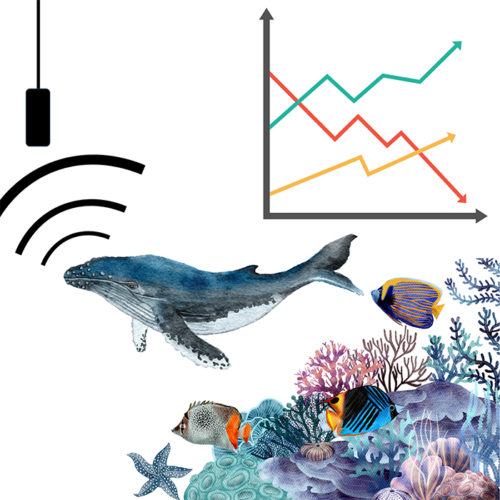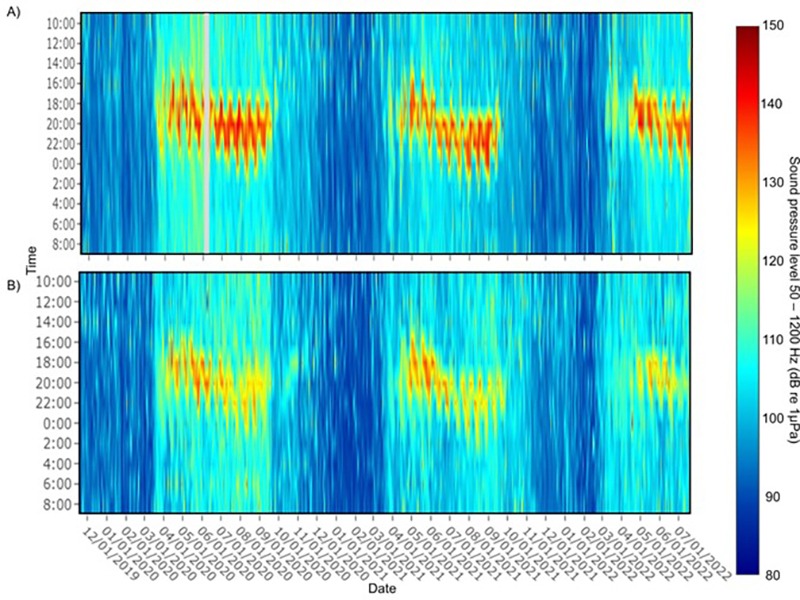
Overview
The BioSound working group is composed of various scientists and stakeholders interested in producing acoustic-based data products that support marine biodiversity monitoring and conservation. BioSound is particularly interested in understanding the value of underwater soundscape metrics as indicators of biological and anthropogenic change in the context of biodiversity conservation. BioSound was formed as an initiative of the Marine Biodiversity Observation Network.
Resources and tools for passive acoustic monitoring (PAM):

Goals and Objectives
The goals of the BioSound working group include:
- As a collaborative group, establish common practices, analytical recommendations, and data standards as it pertains to underwater soundscapes for the purpose of biodiversity monitoring and conservation.
- Provide a collaborative space for individuals and organizations working with bioacoustic soundscape data to share methods and ideas and participate in coordinated research efforts.
We seek to achieve these goals through the following objectives:
- Produce comparable acoustic data products from NOAA IOOS regional networks (e.g. SECOORA), MBON, and MBON-related regions that are informative of Biodiversity and ecosystem/habitat changes.
- Advance the language and applications of Essential Ocean Variables, including the Ocean Sound EOV.
- Assess multiple datasets in variable ocean and coastal environments to establish or identify soundscape metric standards and create meaningful data products from validated soundscape metrics.
- Obtain consensus on data storing and metadata practices from those involved in this effort and share this approach with the broader acoustic community.
- Determine capabilities and limitations of soundscape variables in biodiversity and ecosystem/habitat monitoring.
- Provide resources for those wanting to incorporate soundscape analytical methods in their own research/project efforts.c
- Describe benefits of standardized practices and the need to contribute observations to recommended data storage and distribution repositories.
- Collaboratively participate in grant opportunities and publications.
We envision this effort will assist in the efficient assessment of passive acoustic datasets for temporal trends of biological sounds as represented in the Figure 1 dataset collected in a South Carolina estuary.

Figure 1. Temporal trends in received low frequency (50-1200 Hz) rms sound pressure levels (SPL) measured on the hour in A) Chechessee Creek and B) Colleton River, South Carolina, USA, from November 19th, 2019 to July 20th, 2022. (E. Montie, Unpublished data)
FAQs
Q: Who is leading this project?
A: This is collaborative initiative, which includes the Marine Biodiversity Observation Network (MBON) of the Integrated Ocean Observing System (IOOS, and element of the Global Ocean Observing System). The project leads are Liz Ferguson (Ocean Science Analytics) and Dr. Neil Hammerschlag (Shark Research Foundation Inc.). The core group of participants also includes Eric Montie (University of South Carolina Beaufort), Kate Stafford (Oregon State University), and Jennifer Dorton (Southeast Coastal Ocean Observing Regional Association).
Q: What are the end products and project deliverables?
A: We are initially starting with a smaller effort that involves comparing acoustic-based biodiversity indices across multiple ocean environments. From there we plan to pursue a larger-scale, more comprehensive analysis. Both efforts are intended to produce:
- Data products from regional ocean and coastal environments that are related to biological sounds and/or habitat characteristics.
- Recommendations for the bioacoustic community regarding soundscape metric methods and standards in relation to biological sound.
- Multi-author scientific papers. Data contributors will be co-authors.
Q: What is required for participation in this working group?
A: We do not have stringent requirements, however those with passive acoustic data are asked to contribute to initial or subsequent analysis efforts. If participants do not have data they can contribute, then a background in bioacoustics or marine biodiversity as it relates to sound is most useful in the context of our goals.
Q: What is the timeline for this project?
A: As this is a large-scale project with many collaborators, we predict this to progress over the next few years. In the initial analysis our aim is to produce a publication based on results by the end of 2023. Additional updates regarding the progress of the group will be shared as they arise.
Q: How do I become a collaborator?
A: To join this collaborative initiative, please contact working group co-lead Dr. Neil Hammerschlag (neilhammerschlag@gmail.com), or Liz Ferguson (eferguson@oceanscienceanalytics.com).
